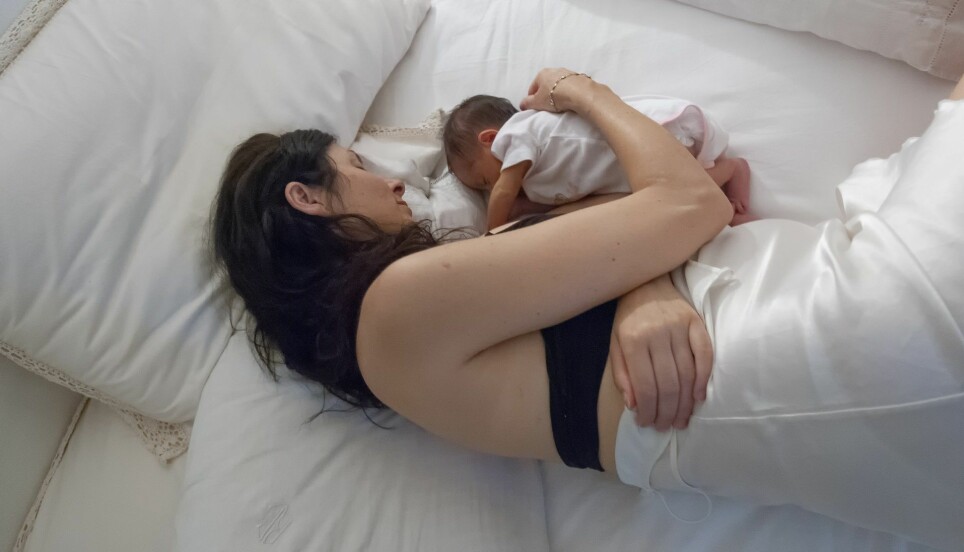
Does lying on your stomach after giving birth help your uterus contract?
ASK A RESEARCHER: Does the uterus need help contracting postpartum? Is there any point to speeding this up? And does it really help to lie on your stomach, as some women are advised to do after giving birth? We've asked the experts.
After giving birth, a mother’s body may feel very different. The abdomen and uterus have been stretched to impressive capacity, and everything needs time to return to normal.
The uterus gradually contracts, but does it need some help getting the job done?
One of our readers reached out to us with this question. After she gave birth, she was advised to lie on her stomach. This would help the uterus to contract, she was told.
But when she tried, she found the position unpleasant. She had a feeling of something heavy resting on her pelvis.
So she started wondering: Does the uterus really need help to contract? Should the process go any faster than it already does? And does the uterus actually get smaller faster from lying on one’s stomach?
Marte Myhre Reigstad thinks is the answer to the last question is no.
Reigstad is a specialist in obstetrics and gynaecology and a researcher at the Norwegian Research Centre for Women's Health at Oslo University Hospital.

The uterus usually manages on its own
Reigstad believes the uterus does not really need help contracting after birth.
“The uterus normally contracts and manages fine on its own,” she says.
“In principle, there’s no point in speeding up the uterine contraction to normal,” Reigstad says.
“The only reason for doing it is that when you lie on your back, the vagina points back and down. When you lie on your stomach, any tissue fragments in the uterus might drain out more easily.”
It isn’t uncommon for this advice to be included in hospital information provided to new mothers. It is usually suggested as an exercise or resting position, with one or two pillows placed under the belly.
Haukeland University Hospital is one of the hospitals that gives this advice in a brochure about exercises women can do postpartum.
Jorunn Tunestveit and Bente Langeland are both professional development midwives at the Haukeland Women's Clinic, and they explain why it may be wise to lie on your stomach in the time immediately postpartum.
The answer mostly has to do with prevention, by ensuring that the uterus is emptied as much as possible.
- RELATED: Did you know that your placenta may reveal your risk of getting preeclampsia?
Giving the uterus best possible conditions
“After birth it’s important for the uterus to be emptied of the naturally occurring bleeding,” the midwives say.
“In obstetrics, we focus on preventing situations that can hinder the normal process where the uterine muscle returns to the way it was before pregnancy. The uterus does this by means of contractions. Blood that stays in the uterine cavity for a long time will coagulate and prevent these important contractions.
The clotted blood can also settle as a plug in the cervix, thus preventing the bleeding from exiting the body, according to Tunestveit and Langeland.
“A uterine cavity that isn’t emptied properly provides a breeding ground for serious infection or severe bleeding. Another important factor is whether the postpartum woman empties her bladder sufficiently, because a full bladder also prevents this natural process.”
- RELATED: Still pregnant? Perhaps you'd like to know the best way for pregnant women to exercise.
Experience from earlier times
In the past, women who had given birth spent a good amount of time resting in bed.
Experiences from that time were that the prone position, as well as the movement from the back to the stomach, had a beneficial effect on the emptying of the uterus, say Tunestveit and Langeland.
“Most women, about 80 percent, have a forward-leaning uterus, and it was logical that a prone position would promote this process. With women being up and about so quickly after giving birth nowadays, this is more important for the emptying of the uterus than having daily periods of lying prone,” say the midwives.
No research has been done on the benefits of lying on one’s stomach after giving birth, according to the midwives.
“But this recommendation is still something that might be helpful, and experience suggests that many women look forward to being able to lie on their stomachs after giving birth,” they say.
Reigstad emphasizes this point. “It can certainly feel good to lie on your stomach after birth. Doing that during pregnancy isn’t possible,” she says.
Can prone position increase risk of abdominal prolapse?
The uncomfortable feeling of heaviness in the abdomen when our reader tried to lie on her stomach after giving birth gave rise to another question: Could lying on one’s stomach actually increase the risk of abdominal prolapse by putting undue strain on the abdomen from the still large uterus resting against the bladder?
“No,” says Reigstad.
Reigstad hasn’t heard of experiences like this from lying prone postpartum.
“I have a hard time believing that a prone position can create the risk of abdominal prolapse,” she says.
“But the feeling may have something to do with the angle. When you lie down, the uterus will fall slightly inward. If you’re lying on your stomach, and the uterus is a little mobile, stretched and enlarged after pregnancy, you may feel that it’s moving down towards the vagina. You might feel it more easily when you lie on your stomach than in other positions,” Reigstad says.
- RELATED: Researchers caution that epidurals do not in themselves improve birth experiences.
Women experience their postpartum body differently
But if lying on your stomach feels very uncomfortable, according to Tunestveit and Langeland, you’ll help your uterus just as much by getting up onto your feet a bit.
How a woman’s body feels after birth varies greatly from person to person, says Reigstad. And it can take a long time before the abdomen feels normal again.
“The uterus should contract. However, the vaginal walls and pelvic floor can also undergo great strain during both pregnancy and childbirth. And that's more complex. A lot that feels unfamiliar right after birth corrects itself over time. We don’t usually make an assessment of abdominal prolapse until a year after childbirth,” Reigstad says.
Translated by: Ingrid P. Nuse
Read the Norwegian version of this article on forskning.no.

































